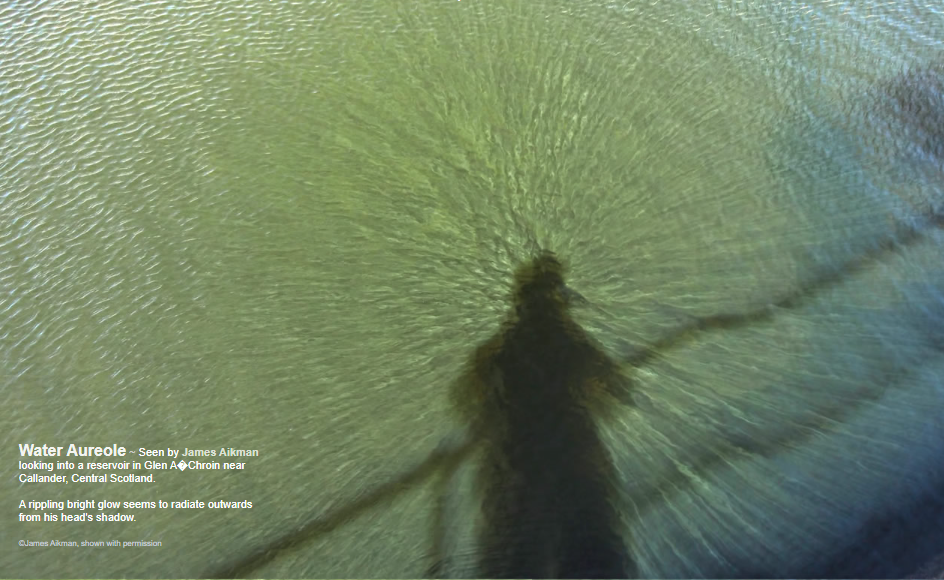Water Aureole - OPOD
Water Aureole - Exploring the Mystical Glow
When gazing into a reservoir in Glen A�Chroin near Callander, Central Scotland, James Aikman was captivated by a mesmerizing phenomenon known as a water aureole. The scene was adorned with a rippling bright glow that seemed to radiate outwards from the shadow cast by his head. This captivating display of atmospheric optics is created by a combination of factors, including a gently wavy surface and slightly turbid water that allows light to shine through and become visible.
The magic of a water aureole lies in the interplay between waves, sunlight, and the scattering of light by particles suspended in the water. As the waves move across the surface, they refract the parallel sun rays, forming caustic sheets. Caustics are bright surfaces where the sun's rays converge and concentrate. In the case of a water aureole, these caustic sheets become visible due to scattering from the turbid water particles.
One interesting aspect of water aureoles is that caustics in clear water are only visible where they intersect the water bed. This means that the presence of a wavy surface is crucial for the formation of this optical phenomenon. Waves create a region of space where refracted sun rays cross, causing the rays to cluster and form bright sheets of light. These sheets join together in a cusp at their top and spread apart below, creating a unique visual effect that is quite different from conventional focusing.
When observing a water aureole, one may notice that the bright caustic sheets appear roughly parallel to the incoming sun rays. However, when looking along these sheets towards the shadow of your own head, they seem to converge or radiate outwards due to perspective. This illusion is similar to the convergence of railway tracks or the appearance of crepuscular rays. The erratic and twisted appearance of the rays is a result of the additional refraction caused by the wavy surface, further enhancing the mystique of this phenomenon.
In conclusion, water aureoles are a captivating display of atmospheric optics that can be witnessed under specific conditions. The interplay between waves, sunlight, and turbid water particles creates bright caustic sheets that seem to radiate outwards from the shadow cast by a person's head. This optical phenomenon is a testament to the wonders of nature and the intricate ways in which light interacts with our environment. So, next time you find yourself near a gently wavy reservoir or body of water, take a moment to appreciate the enchanting beauty of a water aureole.

Water Aureole ~ Seen by James Aikman looking into a reservoir in Glen A�Chroin near Callander, Central Scotland.
A rippling bright glow seems to radiate outwards from his head's shadow.
©James Aikman, shown with permission

An aureole needs a gently wavy surface and slightly turbid water so that light shining through it is visible.
The waves refract parallel sun rays to form caustic sheets. These are bright surfaces where the sun's rays cross and concentrate. More about caustic sheets.
Scattering from the turbid water particles make the causic sheets visible..
Caustics in clear water are only visible where they intersect the water bed.
Waves produce a region of space where refracted sun rays cross.
The rays cluster to form bright sheets of light. The sheets join in a cusp at their top and spread apart below.
This is quite different from conventional focusing.
The bright caustic sheets are roughly parallel to the incoming sun rays. Look along them towards the shadow of your head and they appear by perspective to converge (or radiate outwards). Railway tracks and crepuscular rays do the same.
The rays appear erratic and twisted because we see after more refraction by the wavy surface.
Note: this article has been automatically converted from the old site and may not appear as intended. You can find the original article here.
Reference Atmospheric Optics
If you use any of the definitions, information, or data presented on Atmospheric Optics, please copy the link or reference below to properly credit us as the reference source. Thank you!
-
<a href="https://atoptics.co.uk/blog/water-aureole-opod/">Water Aureole - OPOD</a>
-
"Water Aureole - OPOD". Atmospheric Optics. Accessed on November 26, 2024. https://atoptics.co.uk/blog/water-aureole-opod/.
-
"Water Aureole - OPOD". Atmospheric Optics, https://atoptics.co.uk/blog/water-aureole-opod/. Accessed 26 November, 2024
-
Water Aureole - OPOD. Atmospheric Optics. Retrieved from https://atoptics.co.uk/blog/water-aureole-opod/.